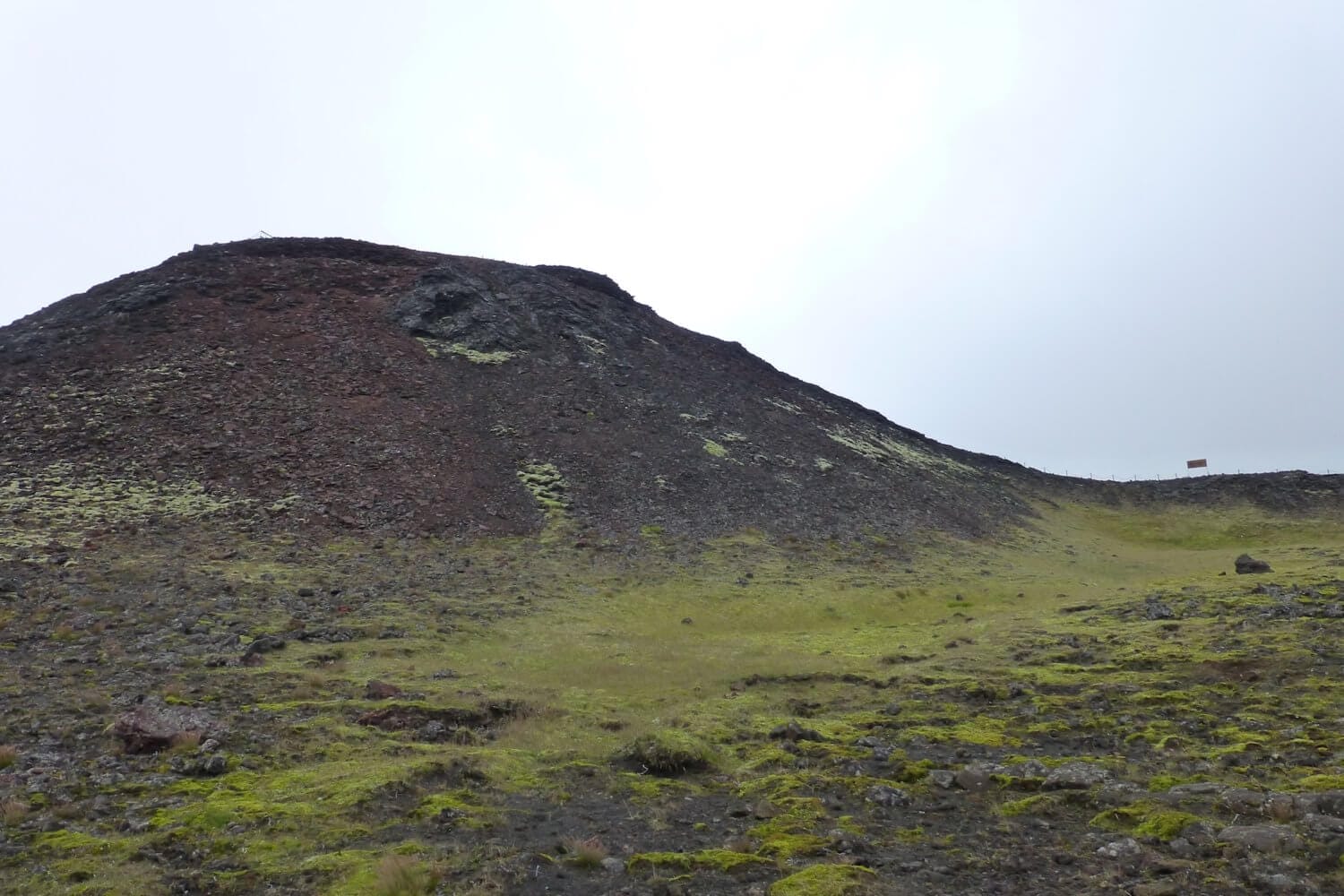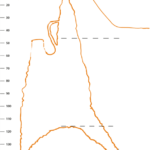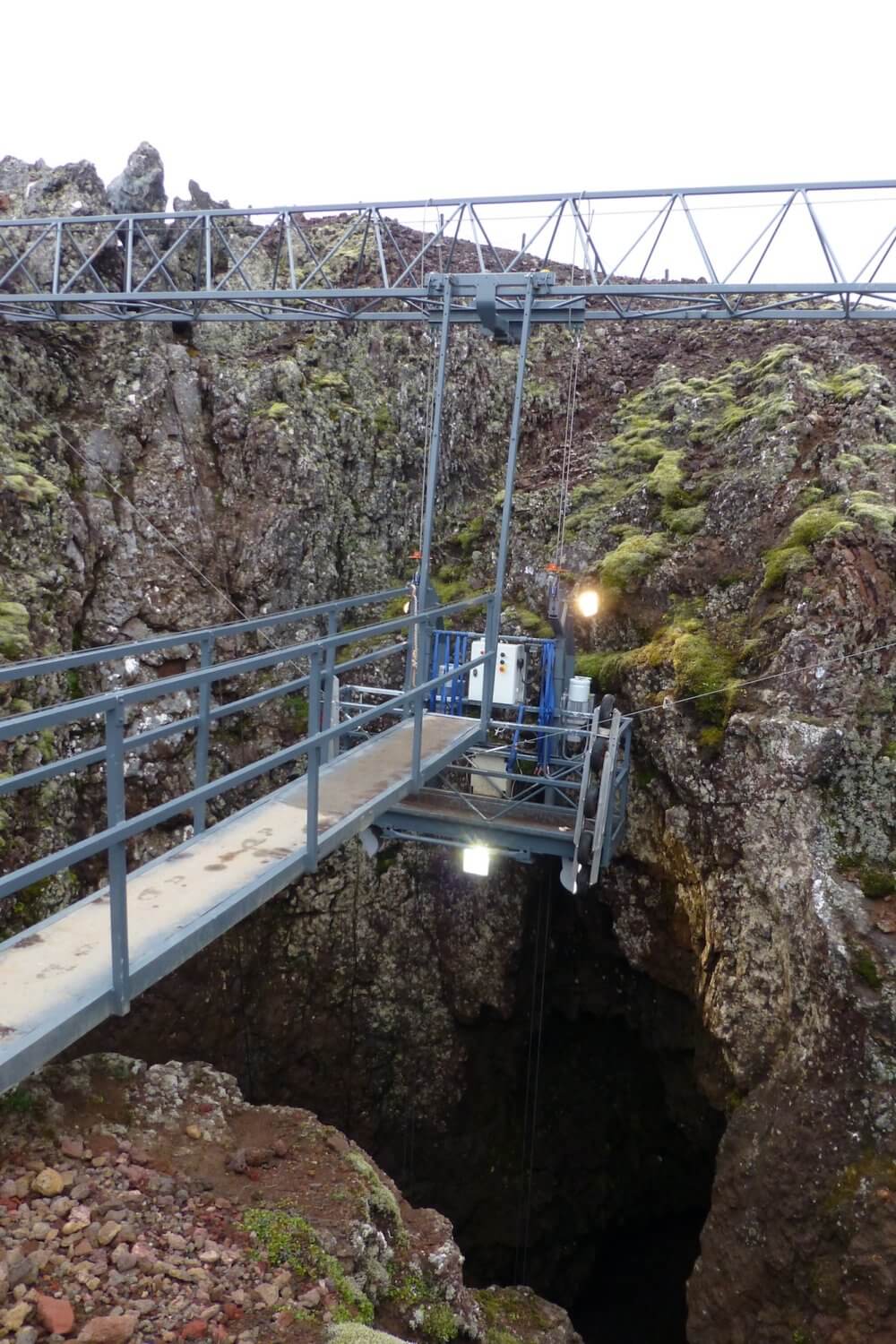
Iceland

Thrihnukagigur Volcano
In southern Iceland, just 13 miles southeast of Reykjavik there is a most odd wonder of nature. A volcano named Thrihnukagigur (good luck pronouncing it). Now, a volcano is not that odd an occurrence you may be thinking, especially in the very seismically active island of Iceland which straddles the Mid Atlantic Ridge not far from the Arctic Circle.
Thrihnukagigur Volcano
This volcano though, is very special. In fact Thrihnukagigur is currently the only volcano in the world that you can descend into its once beating heart, the magma chamber. In the summer months between mid May and mid October, small tour groups are taken by open top cable lift and descend over 400ft inside the dormant volcano. It isn’t extinct, just sleeping. There are no signs that it is going to wake from its 4 millennia nap just yet, so don’t panic.
The tour is ranked as moderate in physicality, or 2/5 on a scale. You need to be able to walk for between 45 minutes to an hour to get to the crater then the same amount of time back to the car park at the purpose built ski centre (a very odd sight in summer with no snow).
Facilities at Thrihnukagigur are limited to a heated port-a-cabin. The volcano, whose unpronounceable name to anyone but a local, translates as ‘Three Peaks Crater’ on account that it is one of three prominent peaks on a ridge in the Bláfjöll Country Park, although you can only descend into the most northerly peak. Because the volcano is in a national park, nothing permanent can be built. It has to be helicoptered in and out at the beginning and end of each season.
Inside The Volcano: The Hike
Before you can descend inside the volcano you first have to get to it. You have three options; drive yourself the 20km if you’re staying in Reykjavik to the meeting point or get the tour company to pick you up and drop you off at your hotel. If the hike is too much energy and you have a fair amount of money burning a hole in your pocket, you can even get helicoptered directly to the camp.
After the previous evenings bar bill came to the same amount as a small apartment in Mayfair, and with a slightly fuzzy head, I opted for the hike. Stepping outside the van in the ski resort car park, the wind took my breath away. I had been in Iceland for a couple of days already so I was used to the low temperatures but the icy cold howling gale that greeted my face in the car park was still a sobering surprise.
Behind me was the barren hill upon which thousands of Icelanders practiced their parallel turns in winter but in the middle of summer the button lifts stood motionless and the huge restaurant at the base had a shut sign on the door like some eery ghost town or deserted film set.

The hike starts in the car park of Bláfjöll Ski Resort, the largest ski resort in Iceland with 15 lifts and 15km of pistes.
Ahead of us, spreading out as far as the horizon was lava field in all directions. Where could we possibly go from here? Our friendly guide pointed us to a small sign that simply had an arrow on it pointing down a small ridge in the solidified lava that wouldn’t even usually rank as a path of any kind.
10 minutes in, and still in sight of the car park, with the wind coming at us from every possible angle, we realised that this was going to be a very long 3km (2 mile) hike.

Looking down from the peak of the volcano across the deserted plains of the Bláfjöll Park. The start point in the ski centre can just be made out in the distance.
The ground beneath our feet was solid lava that, over the course of time since the last eruption around 4000 years ago, had been covered, in parts, by the only thing that can grow in such a harsh climate, moss and lichen.
What wasn’t covered is usually razor sharp rock thanks to the constant battering the landscape here gets from the weather. Be very mindful of twisted ankles here if you lose concentration on where you are walking.
Interspersed with the barrenness were stunning lava tubes you suddenly happen across, formed by fast flowing lava that cools and solidifies at the surface while the centre remains white hot and fluid. When the eruption finishes, huge circular or oval tubes and caverns are all that’s left. In parts the roofs collapse giving hikers a spectacular view into these sometimes huge tubes.
The weather was closing in and the cloud was swirling around in a menacing mist. In the distance a small ridge protruded from the otherwise jagged but flat black desert like surface.
Bounding on ahead of the group, most of which were now struggling a little I started the climb but looking left a small white port-a-cabin appeared through the mist. We had arrived. But where was the volcano?
Inside The Volcano: Base Camp
On a small somewhat flattish plateau to the left of the volcano, the unassuming port-a-cabin had been plonked along with separate chemical toilets that offer almost no respite from the wind.
Inside, the port-a-cabin was thankfully heated and surprisingly well insulated from the threatening apocalypse that was showing no signs of abating outside. Sitting down at a table, I was taken back to my school days once the obligatory health and safety briefing started. Once our 40 minute adventure 400ft below our feet was finished we would be returning here to enjoy a hearty traditional Icelandic meat soup with tea and coffee to warm up from the constant but frigid 6 degrees that is the climate in the magma chamber. Mix in droplets of water from the groundwater that seep through in to the chamber from the surrounding area and, even with layers and gloves you will certainly feel the cold by the time you leave.
Suited and booted we were back outside, this time with added hard hat to make our way up the small hill that is, ridiculously, the cone of the volcano. Jutting out above the surrounding landscape by a mere 35 meters (100ft), how could this possibly be a volcano. I had in my mind, a perfectly symmetrical cone we would have to be clawing our way up, or at least something more prominent than this bump.

Approaching the Volcano, only the base camp, visible once you clear the last ridge, gives away the hill’s prominence in scientific circles.
The early morning mist made getting to the top harder than it should, coating the ground in a thin sliver of moisture making the ascent a one step up, two back affair. I was thankful for the hand railing that had been anchored to the rock.
Making one last turn, I could make out the the truss that the lift mechanism is anchored to before I was blasted with what felt like a hurricane force blast of arctic air that nearly sent me over the side with the grace of Mr Bean in an Olympic gymnastics final.
Inside The Volcano: The Lift
“We’re going down in that?”, protested one of the girls. “Yep”, I replied. Just ahead of us, dangling over a black hole that looked too small to take it, the frankly rather flimsy looking basket was swaying in the abundant breeze. We all looked at each other in disbelief.
Despite the promotional photos on the website, nothing quite prepares your body for the adrenaline rush we were all now feeling, staring at our chariot to hell. It looked like we had the express route to the bottom looking at the impossibly thin wire that was going to support us, 6 at a time, on a 120 meter journey down into the earth’s crust.
Inside The Volcano: The Descent
I hadn’t paid all this money to bail out at the very last minute (this tour, like pretty much everything in Iceland, isn’t cheap). I had paid 25% more than the cost of the flight from Gatwick just for the 6 hour tour today and I was going to get my money’s worth. The real wonder of Thrihnukagigur Volcano is what lies inside, not outside.

Negotiating the impossibly narrow opening of the volcano, you descend until the opening is just a distant spec in the roof of the magma chamber.
Gingerly stepping into the harness and clipping onto safety rail, the bar closed and our guide pressed the basement button and the car shuddered to life. Memories of watching Are You Being Served in the mid 80’s raced through my mind as did the catchy theme tune as the walls of the volcano came right up to our faces.
The 4X4 meter (12X12ft) entrance belies what is underneath. Hand walking our way down a particularly tight section of the opening, the wheels on all four corners of the lift car protecting the cage from what would otherwise be a battering, the chamber suddenly opened up and there was nothing around us but inky black darkness. Our headlamps not powerful enough to shine all the way across the chamber.
Lights at the bottom of the chamber gave a ghost like glow to the floor. The magma chamber itself is enormous. There is no other word for it. From the, now relatively tiny, 12X12ft (4X4m) entrance, the walkable floor space 400ft (120m) below on the plug of lava at the chamber floor measures an incredible 50X70 meters (160X220ft). To put it into context, that’s enough floor space for 3 full sized basketball courts laid side by side.
The cavernous area in between will easily hold the Statue Of Liberty with room to spare. Right now, dangling perilously on some metal string, still 200ft from terrafirma, the vast chamber felt as if it could hold the entire International Space Station!
Inside The Volcano
The first thing that strikes you is how colourful it is inside the magma chamber. 4000 years since this place was full of boiling hot magma, the walls are a veritable rainbow of colours now the rock has had time to cool.
The colours are brought out more thanks to the excellent low level lighting the team have done in the chamber to create a real sense of wonder and awe in everyone that comes here. Real thought has gone into how best to display what is here and it shows.
The colours on the wall tell volcanologists what type of minerals were in the magma. The scientific data this one chamber has given up is shaping volcanology for years to come. One particularly colourful area up on the wall was, scientists believe, a vent where fresh magma was introduced into the chamber. Today it is a 5 storey blue and black marvel. Like the volcano’s own Pablo Picasso. The size and vibrant colours are mesmerising to look at.
You would think that, post eruption, the chamber would be full of superheated magma that then cools and plugs the chamber until the next intrusion of super heated molten rock from deep down in the earths mantle. 99% of the time you would be right but, for some reason, the magma in Thrihnukagigur disappeared after the last eruption. How exactly? Scientists are still unsure but volcanologist Haraldur Sigurdsson, perhaps put it best when he said, “Thrihnukagigur is unique (…) It’s like somebody came and pulled the plug and all the magma ran down out of it.”
In the southeast corner the floor drops off steeply beyond the walkable area a further 300ft (100m). Is this where the magma went? Nobody knows for sure. But the funds that this tour brings in help scientists to study this wonderful gift from Mother Nature and better our understanding of how volcanoes work so that they can make better predictions in the future and save entire communities from losing loved ones.
Sure, this tour isn’t cheap but where else in the world can you see the inner workings of one of the forces that shape our planet today. The money you pay helps support the study of one of the most destructive yet creative forces on our planet while potentially saving countless lives in the process not just in Iceland but around the globe. We can’t do anything currently to stop a volcanic eruption but scientists are getting better at predicting when they are going to happen and this tour directly supports that.
Surely that’s a price worth paying in anyone’s eyes.
If you would like to add this unique adventure to your Iceland itinerary and you are travelling between mid May and Mid October head on over to Inside The Volcano to get your space booked. It’s a one of a kind experience you won’t forget.
 Copyright secured by Digiprove © 2017
Copyright secured by Digiprove © 2017









